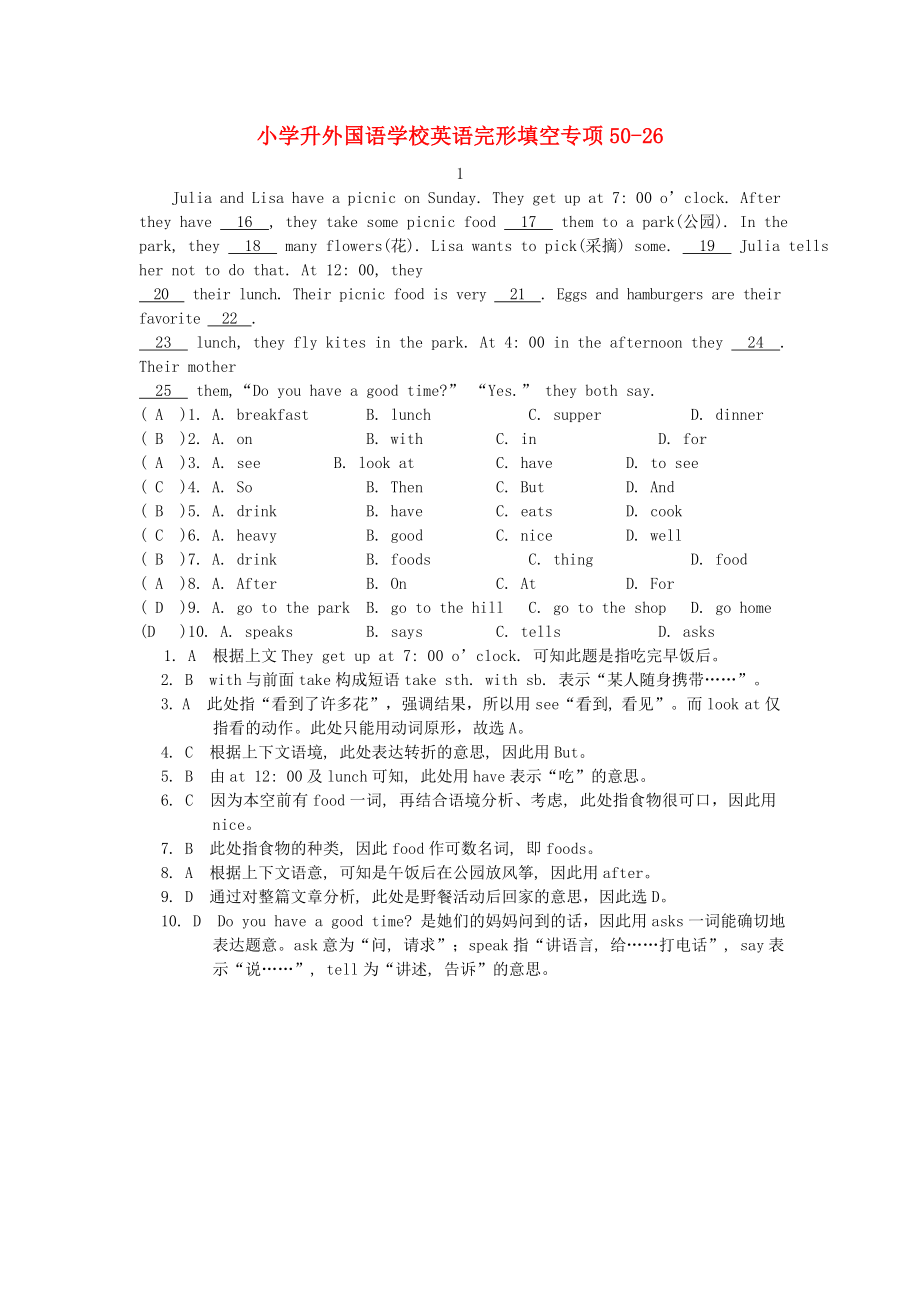《寧夏外國(guó)語(yǔ)學(xué)校小升初英語(yǔ)專項(xiàng)訓(xùn)練 完形填空27》由會(huì)員分享����,可在線閱讀,更多相關(guān)《寧夏外國(guó)語(yǔ)學(xué)校小升初英語(yǔ)專項(xiàng)訓(xùn)練 完形填空27(2頁(yè)珍藏版)》請(qǐng)?jiān)谘b配圖網(wǎng)上搜索����。
1、小學(xué)升外國(guó)語(yǔ)學(xué)校英語(yǔ)完形填空專項(xiàng)50-26
1
Julia and Lisa have a picnic on Sunday. They get up at 7: 00 o’clock. After they have 16 , they take some picnic food 17 them to a park(公園). In the park, they 18 many flowers(花). Lisa wants to pick(采摘) some. 19 Julia tells her not to do that. At 12: 00, they
2����、
20 their lunch. Their picnic food is very 21 . Eggs and hamburgers are their favorite 22 .
23 lunch, they fly kites in the park. At 4: 00 in the afternoon they 24 . Their mother
25 them,“Do you have a good time?” “Yes.” they both say.
( A )1. A. breakfast B. lunch C. sup
3、per D. dinner
( B )2. A. on B. with C. in D. for
( A )3. A. see B. look at C. have D. to see
( C )4. A. So B. Then C. But D. And
( B )5. A. drink B. have C. eats D. cook
( C )6. A. heavy B. good C. nice D. well
( B )7. A. drink B. foods C. thing D
4����、. food
( A )8. A. After B. On C. At D. For
( D )9. A. go to the park B. go to the hill C. go to the shop D. go home
(D )10. A. speaks B. says C. tells D. asks
1. A 根據(jù)上文They get up at 7: 00 o’clock. 可知此題是指吃完早飯后����。
2. B with與前面take構(gòu)成短語(yǔ)take sth. with sb. 表示“某人隨身攜帶……”����。
3. A 此處指
5、“看到了許多花”����,強(qiáng)調(diào)結(jié)果,所以用see“看到, 看見(jiàn)”����。而look at僅指看的動(dòng)作。此處只能用動(dòng)詞原形����,故選A。
4. C 根據(jù)上下文語(yǔ)境, 此處表達(dá)轉(zhuǎn)折的意思, 因此用But����。
5. B 由at 12: 00及l(fā)unch可知, 此處用have表示“吃”的意思。
6. C 因?yàn)楸究涨坝衒ood一詞, 再結(jié)合語(yǔ)境分析����、考慮, 此處指食物很可口����,因此用nice����。
7. B 此處指食物的種類, 因此food作可數(shù)名詞, 即foods。
8. A 根據(jù)上下文語(yǔ)意, 可知是午飯后在公園放風(fēng)箏, 因此用after����。
9. D 通過(guò)對(duì)整篇文章分析, 此處是野餐活動(dòng)后回家的意思,因
6����、此選D����。
10. D Do you have a good time? 是她們的媽媽問(wèn)到的話,因此用asks一詞能確切地表達(dá)題意����。ask意為“問(wèn), 請(qǐng)求”;speak指“講語(yǔ)言, 給……打電話”, say表示“說(shuō)……”, tell為“講述, 告訴”的意思����。
2
1 Miss Gao’s class there 2 44 students. They are 22 boys and 22 3 . All of the students are 4 the playground now. They are 5
7����、 games. 6 are playing football. Some are jumping. Some are running. 7 are the twins? They are 8 there. Look! Lucy is wearing green trousers 9 a white blouse. Lily 10 blue trousers and a yellow sweater. They are playing happily.
( A )1.A. In B. On C. At D. Of
( D )2.A. be
8����、 B. am C. is D. are
( D )3.A. boys B. students C. girl D. girls
( B )4.A. in B. on C. at D. under
( C )5.A. play B. plays C. playing D. to play
( A )6.A. Some B. Other C. Another D. Others
( A )7.A. Where B. Who C. What D. Whose
( B )8.A. / B. over C.
9、at D. on
( B )9.A. but B. and C. or D. so
( D )10.A. wear B. is wear C. wearing D. is wearing
1. A “在班上”應(yīng)為in…class, 介詞用in����,故本題選擇A選項(xiàng)。
2. D 本題主要考查There be句型中be 動(dòng)詞的選擇����。因后面44 students, 是復(fù)數(shù),所以選用are, 即D選項(xiàng)����。
3. D 此句意為:他們是22個(gè)男孩和22個(gè)女孩。故本題應(yīng)用girls����,即D選項(xiàng)。
4. B “在操場(chǎng)上”應(yīng)表達(dá)為on the playground,介
10����、詞用on, 即B選項(xiàng)����。
5. C 本題主要考查現(xiàn)在進(jìn)行時(shí)構(gòu)成be+doing����。根據(jù)句意“他們正在做游戲”的空前的are,可以判定應(yīng)用現(xiàn)在分詞形式����,即C選項(xiàng)。
6. A 本題主要考查不完全列舉的表達(dá)方法����。“一些…一些…”應(yīng)表達(dá)為“ some…some…”����,故本題選擇A選項(xiàng)����。
7.A 本題主要考查對(duì)上下文的理解。此句為問(wèn)句����,通過(guò)下文“他們?cè)谀莾骸?���,可以判定此處是?wèn)“她們?cè)谀膬骸?���,where符合題意,選擇A
8. B “在那邊”的英文表達(dá) “over there”
9. B 此句為:露茜穿著綠褲子����、白襯衫?���?梢缘弥獞?yīng)為并列關(guān)系,用and, 即B選項(xiàng)����。
10.D 上面提及露茜穿的衣服,這里是在說(shuō)莉莉的著裝����,應(yīng)用is wearing,即D選項(xiàng)。
 寧夏外國(guó)語(yǔ)學(xué)校小升初英語(yǔ)專項(xiàng)訓(xùn)練 完形填空27
寧夏外國(guó)語(yǔ)學(xué)校小升初英語(yǔ)專項(xiàng)訓(xùn)練 完形填空27

